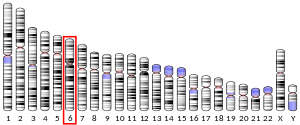SESN1
Sestrin 1, also known as p53-regulated protein PA26, is a protein that in humans is encoded by the SESN1 gene. This gene encodes a member of the sestrin family. Sestrins are induced by the p53 tumor suppressor protein and play a role in the cellular response to DNA damage and oxidative stress. The encoded protein mediates p53 inhibition of cell growth by activating AMP-activated protein kinase, which results in the inhibition of the mammalian target of rapamycin protein. The encoded protein also plays a critical role in antioxidant defense by regenerating overoxidized peroxiredoxins, and the expression of this gene is a potential marker for exposure to radiation. Alternatively spliced transcript variants encoding multiple isoforms have been observed for this gene..[5][6][7]
See also
References
- 1 2 3 GRCh38: Ensembl release 89: ENSG00000080546 - Ensembl, May 2017
- 1 2 3 GRCm38: Ensembl release 89: ENSMUSG00000038332 - Ensembl, May 2017
- ↑ "Human PubMed Reference:".
- ↑ "Mouse PubMed Reference:".
- ↑ "Entrez Gene: sestrin 1".
- ↑ Buckbinder L, Talbott R, Seizinger BR, Kley N (October 1994). "Gene regulation by temperature-sensitive p53 mutants: identification of p53 response genes". Proceedings of the National Academy of Sciences of the United States of America. 91 (22): 10640–4. PMC 45077
 . PMID 7938006. doi:10.1073/pnas.91.22.10640.
. PMID 7938006. doi:10.1073/pnas.91.22.10640. - ↑ Velasco-Miguel S, Buckbinder L, Jean P, Gelbert L, Talbott R, Laidlaw J, Seizinger B, Kley N (January 1999). "PA26, a novel target of the p53 tumor suppressor and member of the GADD family of DNA damage and growth arrest inducible genes". Oncogene. 18 (1): 127–37. PMID 9926927. doi:10.1038/sj.onc.1202274.
Further reading
- Budanov AV, Sablina AA, Feinstein E, Koonin EV, Chumakov PM (April 2004). "Regeneration of peroxiredoxins by p53-regulated sestrins, homologs of bacterial AhpD". Science. 304 (5670): 596–600. PMID 15105503. doi:10.1126/science.1095569.
- Peeters H, Debeer P, Bairoch A, Wilquet V, Huysmans C, Parthoens E, Fryns JP, Gewillig M, Nakamura Y, Niikawa N, Van de Ven W, Devriendt K (May 2003). "PA26 is a candidate gene for heterotaxia in humans: identification of a novel PA26-related gene family in human and mouse". Human Genetics. 112 (5-6): 573–80. PMID 12607115. doi:10.1007/s00439-003-0917-5.



